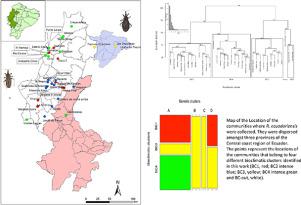当前位置:
X-MOL 学术
›
Acta Trop.
›
论文详情
Our official English website, www.x-mol.net, welcomes your feedback! (Note: you will need to create a separate account there.)
Would tropical climatic variations impact the genetic variability of triatomines: Rhodnius ecuadoriensis, principal vector of Chagas disease in Ecuador?
Acta Tropica ( IF 2.7 ) Pub Date : 2020-05-19 , DOI: 10.1016/j.actatropica.2020.105530 Anita G Villacís 1 , Juan José Bustillos 2 , Stéphanie Depickère 3 , Dino Sánchez 2 , César A Yumiseva 2 , Ana Troya-Zuleta 4 , Christian Barnabé 5 , Mario J Grijalva 1 , Simone Frédérique Brenière 6
Acta Tropica ( IF 2.7 ) Pub Date : 2020-05-19 , DOI: 10.1016/j.actatropica.2020.105530 Anita G Villacís 1 , Juan José Bustillos 2 , Stéphanie Depickère 3 , Dino Sánchez 2 , César A Yumiseva 2 , Ana Troya-Zuleta 4 , Christian Barnabé 5 , Mario J Grijalva 1 , Simone Frédérique Brenière 6
Affiliation

|
Rhodnius ecuadoriensis is one of the most important vector species of Chagas disease in Ecuador. This species is distributed in the Central coast region and in the south Andean region, and an incipient speciation process between these geographical populations was previously proposed. The current population genetics study only focused on the Central coast region and analyzed 96 sylvatic specimens of R. ecuadoriensis associated with Phytelephas aequatorialis palm trees. We used Cytb and 16S-rRNA sequences and a Cytb-16S-rRNA concatenated set to explore (i) the genetic variability, spatial structuring, and demographic history of R. ecuadoriensis, and to determine (ii) the relationship between the genetic and climatic variabilities. A particularly high genetic variability was observed without detectable general genetic structure; only some terminal genetic clusters were observed. We did not observe isolation by geographical distance (IBD), and it is likely that ancient expansion occurred, according to Fs index and mismatch distribution for Cytb-16S-rRNA concatenated sequences. Hierarchical clustering showed that the current locality origins of the bugs were grouped into four bioclimatic clusters. Genetic and bioclimatic distances were not correlated, but some genetic clusters were associated with bioclimatic ones. The results showed an ancient evolution of the species in the region with a possible old expansion. The absence of spatial genetic structure could be due to climatic conditions (possible selection of singular genotypes) and to passive transportation of palms tree materials where R. ecuadoriensis are living.
中文翻译:

热带气候变化是否会影响三类植物素的遗传变异性:厄瓜多尔恰加斯病的主要传播者,厄瓜多尔Rhodnius ecuadoriensis?
厄瓜多尔红球菌是厄瓜多尔恰加斯病最重要的媒介物种之一。该物种分布在中部沿海地区和安第斯南部地区,以前曾提出过这些地理种群之间的初期物种形成过程。当前的种群遗传学研究仅集中在中部沿海地区,并分析了96例厄瓜多尔立克次体与赤潮疫霉棕榈树相关的龙眼标本。我们使用Cytb和16S-rRNA序列以及一个Cytb-16S-rRNA串联集来探索(i)厄瓜多尔犬的遗传变异性,空间结构和人口历史,并确定(ii)遗传与气候之间的关系变异性。观察到特别高的遗传变异性,没有可检测到的一般遗传结构;仅观察到一些末端遗传簇。我们没有观察到通过地理距离(IBD)进行隔离,并且根据Cysb-16S-rRNA串联序列的Fs指数和错配分布,很可能发生了古代扩张。层次聚类表明,当前臭虫的起源起源被分为四个生物气候聚类。遗传和生物气候的距离不相关,但是一些遗传集群与生物气候的集群相关。结果显示该地区该物种的古代演化,并可能有旧扩展。空间遗传结构的缺乏可能是由于气候条件(可能选择单一基因型)和厄瓜多尔河生活的棕榈树材料的被动运输所致。我们没有观察到通过地理距离(IBD)进行隔离,并且根据Cysb-16S-rRNA串联序列的Fs指数和错配分布,很可能发生了古代扩张。层次聚类表明,当前臭虫的起源起源被分为四个生物气候聚类。遗传和生物气候的距离不相关,但是一些遗传集群与生物气候的集群相关。结果表明该地区该物种已发生了古老的演化,并可能出现了旧的扩展。空间遗传结构的缺乏可能是由于气候条件(可能选择单一基因型)和厄瓜多尔河生活的棕榈树材料的被动运输所致。我们没有观察到通过地理距离(IBD)进行隔离,并且根据Cysb-16S-rRNA串联序列的Fs指数和错配分布,很可能发生了古代扩张。层次聚类表明,当前臭虫的起源起源被分为四个生物气候聚类。遗传和生物气候的距离不相关,但是一些遗传集群与生物气候的集群相关。结果显示该地区该物种的古代演化,并可能有旧扩展。空间遗传结构的缺乏可能是由于气候条件(可能选择单一基因型)和厄瓜多尔河生活的棕榈树材料的被动运输所致。根据Cysb-16S-rRNA串联序列的Fs指数和错配分布。层次聚类表明,当前臭虫的起源起源被分为四个生物气候聚类。遗传和生物气候的距离不相关,但是一些遗传集群与生物气候的集群相关。结果显示该地区该物种的古代演化,并可能有旧扩展。空间遗传结构的缺乏可能是由于气候条件(可能选择单一基因型)和厄瓜多尔河生活的棕榈树材料的被动运输所致。根据Cysb-16S-rRNA串联序列的Fs指数和错配分布。层次聚类表明,当前臭虫的起源起源被分为四个生物气候聚类。遗传和生物气候的距离不相关,但是一些遗传集群与生物气候的集群相关。结果显示该地区该物种的古代演化,并可能有旧扩展。空间遗传结构的缺乏可能是由于气候条件(可能选择单一基因型)和厄瓜多尔河生活的棕榈树材料的被动运输所致。遗传和生物气候的距离不相关,但是一些遗传集群与生物气候的集群相关。结果显示该地区该物种的古代演化,并可能有旧扩展。空间遗传结构的缺乏可能是由于气候条件(可能选择单一基因型)和厄瓜多尔河生活的棕榈树材料的被动运输所致。遗传和生物气候的距离不相关,但是一些遗传集群与生物气候的集群相关。结果显示该地区该物种的古代演化,并可能有旧扩展。空间遗传结构的缺乏可能是由于气候条件(可能选择单一基因型)和厄瓜多尔河生活的棕榈树材料的被动运输所致。
更新日期:2020-05-19
中文翻译:

热带气候变化是否会影响三类植物素的遗传变异性:厄瓜多尔恰加斯病的主要传播者,厄瓜多尔Rhodnius ecuadoriensis?
厄瓜多尔红球菌是厄瓜多尔恰加斯病最重要的媒介物种之一。该物种分布在中部沿海地区和安第斯南部地区,以前曾提出过这些地理种群之间的初期物种形成过程。当前的种群遗传学研究仅集中在中部沿海地区,并分析了96例厄瓜多尔立克次体与赤潮疫霉棕榈树相关的龙眼标本。我们使用Cytb和16S-rRNA序列以及一个Cytb-16S-rRNA串联集来探索(i)厄瓜多尔犬的遗传变异性,空间结构和人口历史,并确定(ii)遗传与气候之间的关系变异性。观察到特别高的遗传变异性,没有可检测到的一般遗传结构;仅观察到一些末端遗传簇。我们没有观察到通过地理距离(IBD)进行隔离,并且根据Cysb-16S-rRNA串联序列的Fs指数和错配分布,很可能发生了古代扩张。层次聚类表明,当前臭虫的起源起源被分为四个生物气候聚类。遗传和生物气候的距离不相关,但是一些遗传集群与生物气候的集群相关。结果显示该地区该物种的古代演化,并可能有旧扩展。空间遗传结构的缺乏可能是由于气候条件(可能选择单一基因型)和厄瓜多尔河生活的棕榈树材料的被动运输所致。我们没有观察到通过地理距离(IBD)进行隔离,并且根据Cysb-16S-rRNA串联序列的Fs指数和错配分布,很可能发生了古代扩张。层次聚类表明,当前臭虫的起源起源被分为四个生物气候聚类。遗传和生物气候的距离不相关,但是一些遗传集群与生物气候的集群相关。结果表明该地区该物种已发生了古老的演化,并可能出现了旧的扩展。空间遗传结构的缺乏可能是由于气候条件(可能选择单一基因型)和厄瓜多尔河生活的棕榈树材料的被动运输所致。我们没有观察到通过地理距离(IBD)进行隔离,并且根据Cysb-16S-rRNA串联序列的Fs指数和错配分布,很可能发生了古代扩张。层次聚类表明,当前臭虫的起源起源被分为四个生物气候聚类。遗传和生物气候的距离不相关,但是一些遗传集群与生物气候的集群相关。结果显示该地区该物种的古代演化,并可能有旧扩展。空间遗传结构的缺乏可能是由于气候条件(可能选择单一基因型)和厄瓜多尔河生活的棕榈树材料的被动运输所致。根据Cysb-16S-rRNA串联序列的Fs指数和错配分布。层次聚类表明,当前臭虫的起源起源被分为四个生物气候聚类。遗传和生物气候的距离不相关,但是一些遗传集群与生物气候的集群相关。结果显示该地区该物种的古代演化,并可能有旧扩展。空间遗传结构的缺乏可能是由于气候条件(可能选择单一基因型)和厄瓜多尔河生活的棕榈树材料的被动运输所致。根据Cysb-16S-rRNA串联序列的Fs指数和错配分布。层次聚类表明,当前臭虫的起源起源被分为四个生物气候聚类。遗传和生物气候的距离不相关,但是一些遗传集群与生物气候的集群相关。结果显示该地区该物种的古代演化,并可能有旧扩展。空间遗传结构的缺乏可能是由于气候条件(可能选择单一基因型)和厄瓜多尔河生活的棕榈树材料的被动运输所致。遗传和生物气候的距离不相关,但是一些遗传集群与生物气候的集群相关。结果显示该地区该物种的古代演化,并可能有旧扩展。空间遗传结构的缺乏可能是由于气候条件(可能选择单一基因型)和厄瓜多尔河生活的棕榈树材料的被动运输所致。遗传和生物气候的距离不相关,但是一些遗传集群与生物气候的集群相关。结果显示该地区该物种的古代演化,并可能有旧扩展。空间遗传结构的缺乏可能是由于气候条件(可能选择单一基因型)和厄瓜多尔河生活的棕榈树材料的被动运输所致。



























 京公网安备 11010802027423号
京公网安备 11010802027423号